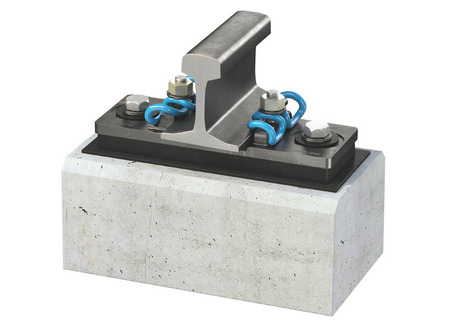Elastic Ribbed Base Plate Support
Elastic supports for rails or ribbed plates are used for improved distribution of wheel load, reduction of RCF damages and vibration decoupling of the rail from the substructure.
Elastic supports for rails or ribbed plates are used for improved distribution of wheel load, reduction of RCF damages and vibration decoupling of the rail from the substructure.

Elastic supports for rails or ribbed plates are used for improved distribution of wheel load, reduction of RCF damages and vibration decoupling of the rail from the substructure. For this purpose, elastic intermediate plates, socalled pads are arranged between ribbed base plates and supporting surfaces, e.g. concrete sleepers. These pads can be adjusted in shape and function to the conditions in the turnout and feature differentiated spring stiffness values according to the special requirements and targets of the customer. Static stiffness values of 4 to 25 kN/mm can be achieved with the elastic ribbed plate support ERL 17.5 - P. The ERL 17.5 - P is particularly suitable for a wide variety of ballast less track systems on slab tracks, bridges and tunnels, but also for ballasted track systems on main lines, light rail tracks, metros and the like. Another area of application for elastic ribbed plate supports is the minimization of structureborne noise on bridges and in tunnels.
Technical description:
For this purpose, elastic intermediate plates, socalled pads are arranged between ribbed base plates and supporting surfaces, e.g. concrete sleepers. These pads can be adjusted in shape and function to the conditions in the turnout and feature differentiated spring stiffness values according to the special requirements and targets of the customer. Static stiffness values of 30 and 40 kN/mm can be achieved with the elastic ribbed plate support ERL 30-P. The ERL 30-P is intended for the use in ballasted track. Another area of application for elastic ribbed plate supports is the minimization of structureborne noise.
Technical description: